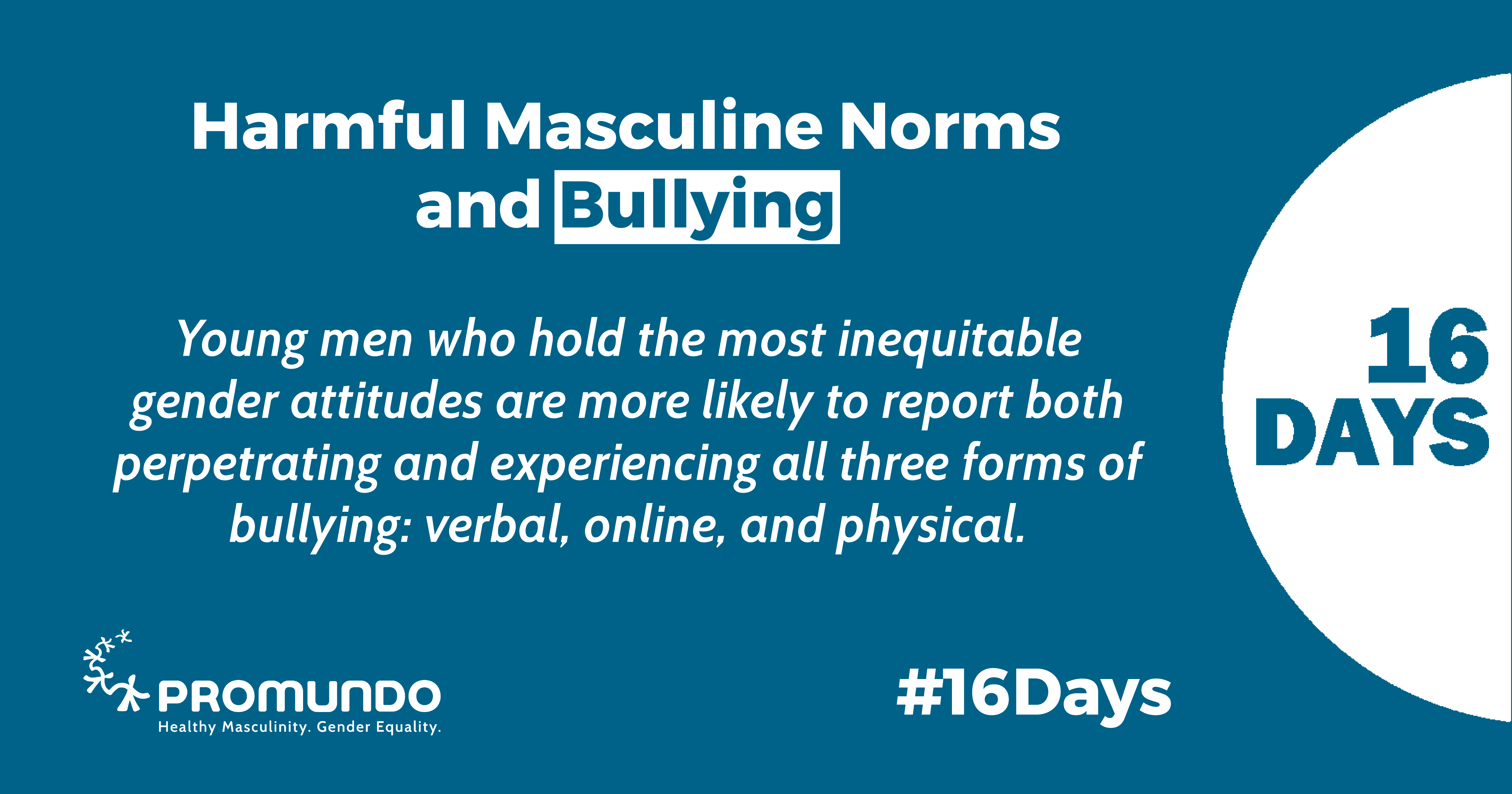The 16 Days of Activism Against Gender-Based Violence is an international campaign used by activists around the world (November 25-December 10) as an organizing strategy to call for the elimination of all forms of gender-based violence.
This year, we will be sharing out research on the links between harmful masculine norms and eight different forms of violent behavior, as well as insights and recommendations to eliminate all forms of violence.

While there is nothing inherent about being male that drives violence, how we socialize boys into their identities as men and what we expect of them – that is, society’s masculine norms – are undeniably linked with violence.
Indeed, boys and men are often raised, socialized, and encouraged to use violence in some form; on the whole, men and boys are disproportionately likely to both perpetrate most forms of violence and to die by homicide and suicide. However, the research affirms that this violence is preventable, gender equality is achievable, and nonviolent norms and ideas about manhood are prevalent and powerful.
Equimundo and Oak Foundation’s report Masculine Norms and Violence: Making the Connections, examines the links between harmful masculine norms and eight forms of violent behavior. This fourth blog in the Making the Connections, 16 Days of Activism series focuses on bullying. It breaks down the facts on bullying, explores its linkages to other forms of violence, and provides recommendations for action.
Bullying
The Facts
Bullying by men and boys takes many forms. In a 2017 study, The Man Box, more than one-third of young men in the United States, the United Kingdom, and Mexico reported having perpetrated verbal, physical, and/or online bullying in the month prior to data collection.
Being a victim of bullying is a common experience for young people, and some youth are aware that identifying as LGBTQIA+ was a reason behind their being bullied. Youth who do not conform to social norms related to gender and sexuality are at the highest risk of being bullied.
Children often experience bullying differently. Boys are more likely to be recognized by others as victims of bullying. However, boys are more likely than girls to experience harmful – rather than helpful or supportive – public acknowledgment of this victimization.
The Links
Masculinities are often at the root of men’s perpetration of bullying. In The Man Box study, young men who held the most inequitable gender attitudes (about a variety of themes, not only violence) were significantly more likely to report both perpetrating and experiencing all three forms of bullying: verbal, online, and physical.
Research suggests that bullying behaviors often share common root causes: the perpetrator’s desire to demonstrate power and control over the victim, and the use of bullying to enforce gender conformity. Many researchers conclude that gender identity and violent gender norms contribute to bullying, alongside many other interwoven factors.
Bullying can provide a pathway to achieve or maintain social status within group settings such as schools and workplaces.
The Intersections
Any thorough explanation of bullying behavior must include influences beyond dominant, or hegemonic, masculinity. Analyses of these causes identify a variety of intersecting levels of influences: the individual, family influences, peer influences, school influences, and community/cultural influences (including poverty and media influences).
Children who are exposed to contexts and relationships with extensive conflict, hostility, and abuse are more likely to perpetrate bullying, a finding similar to other forms of violence for which there is intergenerational transmission. Hostile family and educational environments have been consistently found to be risk factors for bullying.
Physical location, social context, and age intersect with and normalize boys’ and men’s perpetration of bullying. For instance, in school contexts, boys’ physical aggression is often legitimized as “boys will be boys,” whereas the same behavior by girls raises questions, and the same behavior by a middle-aged man in a work setting might be considered inappropriate.
From Theory to Practice
Very few bullying-prevention programs, particularly in the Global South, work to deconstruct harmful masculinities. Initiatives aiming to prevent bullying should focus on the following transformations of harmful masculine norms:
- Engage individuals of all gender identities in discussions about how traditional gender norms and gender nonconformity are connected with perpetration and experiences of bullying.
- Explain, illustrate, and discuss the direct connection between the perpetration of bullying and power, control, and social acceptance, being careful to do so in a way that invites self-awareness rather than places blame.
- Provide participants with a safe space to practice nonviolent, healthier ways to navigate peer groups and social dynamics.
- Discuss ways that participants can foster group settings and peer networks that value healthy expressions of masculinity and embrace, rather than punish, individual differences.
